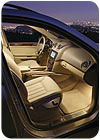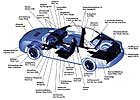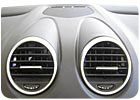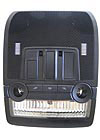
Dr. Schneider produces interior automotive components for high-end car models such as the Mercedes-Benz M-Class, shown here. Photo courtesy of DaimlerChrysler.

Dr. Schneider specializes in producing interior automotive components for car models covering the spectrum from the Ford Fiesta to the Daimler Chrysler Maybach.
The development of finishing technology has paralleled these innovations in interior automotive components. Not only do coating suppliers have to deal with unique substrates such as polyolefins, polyamides, polyurethanes and polymer alloys, but they also must provide a finishing system that is economical, consistent and environmentally friendly. The age-old methods of pretreating and finishing metal have been scrapped to make way for the complex techniques required to clean and coat polymeric surfaces.
Dr. Schneider is a family-owned, German-based company with manufacturing operations scattered across most of the globe. The company specializes in producing interior automotive components for car models covering the spectrum from the Ford Fiesta to the Daimler Chrysler Maybach. The bulk of its business supports high-end models produced by BMW and Mercedes; its bailiwick is manufacturing air registers, console frames and the control elements associated with lighting and environmental comfort. These components are highly visible and therefore must convey opulence consistent with the overall styling of the automobile.
The evolution of the finishing technology used for these components extends beyond mere form and function. Some finishes are actually integral to the function of the switches. A number of automotive designers have engineered switches that indicate position by backlighting a translucent image in the switch. To achieve this effect, a typically dark coating is applied to the translucent white switch, and an image is laser etched through the coating, thereby creating the graphic and exposing the translucent white substrate that allows the backlight to illuminate. The coating used in this application must provide the specified color, gloss, feel and performance, while also possessing the ability to withstand the laser etching process.

Mercedes M-Class air vents produced by Dr. Schneider.
Applying a Finish to Plastic Automotive Components
Dr. Schneider manufactures its parts by automatically injecting polymers into tight-tolerance tools. The parts are then placed on specially designed racks that carry the parts through the entire finishing process. Injection molded plastic presents a delicate surface to coat. The surface tension of the plastic typically makes wetting out the surface with conventional paints problematic. Furthermore, an electrostatic charge can accumulate on the surface, causing irregular paint flow and visual defects. In addition, the handling of parts, however meticulous, can introduce contaminants on the surface.Because of these challenges, the need for innovative pretreatment and cleaning is paramount. The company uses cleaning and pretreatment chemistries developed in Germany by Kluthe to prepare the plastic parts for finishing. The system, which is based on proprietary technology, is completely automated and maintained by sophisticated electronic controls.
According to Peter Dority, vice president of sales for Coral Chemical, Kluthe’s U.S. sales, manufacturing and service partner, “The [pretreatment] products are used to clean the plastic and leave it salt-free for painting.” The system also eliminates static buildup and conditions the surface to provide optimal wetting and adhesion of the waterborne paint.
The pretreated parts exit the cleaning process and are dried in a high velocity convection oven. The clean, dry parts are then automatically finished with multiple coats of a water-based 2K paint provided by Worwag Coatings, LLC, a subsidiary of Karl Worwag Lack- und Farbenfabrik GmbH & Co. KG. The coated parts undergo a brief heating cycle and exit the finishing process.
At this juncture in the process, some parts have graphics laser etched into the finish. The etching process creates an image that is then automatically inspected and graded either acceptable or unacceptable. Images not meeting the specification are etched with an “X” and are discarded by quality inspectors.
The finished parts are then incorporated into sub-assemblies and packaged for shipment.

A BMW E70 overhead console produced by Dr. Schneider.
Dealing with Paint Overspray
Dr. Schneider uses waterborne 2K coatings for the majority of its finishing. The overspray is captured by a water-wash cascade that constantly flows beneath the racks of parts as they traverse the application stage. The overspray needs to be separated from the circulating water so it can be collected and packaged for disposal.The company uses a system developed by Coral Chemical, again in conjunction with its German partner Kluthe, to detackify the paint solids and segregate them from the circulating water. The system uses proprietary polymer technology to kill, float and remove the paint overspray. According to Dority, the system is designed to be compact, and it uses smaller amounts of water and chemicals compared to other separation technologies to minimize the environmental impact.
For the company that boasts a history of “success through innovation,” every stage of the manufacturing process is designed to be state-of-the-art. Such dedication to continuous progress likely will help Dr. Schneider maintain a competitive edge in plastic automotive components for decades to come.
************************
About Dr. Schneider Automotive Systems, Inc.
Dr. Schneider Automotive Systems is a division of Dr. Schneider Holding GmbH in Kronach-Neuses, Germany. Its inauspicious start came in 1927 as a cigar-rolling business. With time, the needs of its customers prompted the company to manufacture ashtrays as an adjunct to its cigars. Eventually Dr. Schneider’s expertise evolved into supplying ashtrays and interior components to the automotive industry.The Dr. Schneider Holding Group remains family owned and managed. Dr. Franz Schneider, the company’s namesake and an octogenarian, still oversees some of the operations. His distinguished guidance has allowed the company to grow in a measured fashion. His daughters, Annette Meserle and SylviaSchmidt, are also involved in managing the company.
2100 employees work at a total of 14 locations, including eight manufacturing plants spanning Germany, Brazil, Spain, Poland and the U.S. Group sales exceed €250 million in 2006. Dr. Schneider consumes more than 16,000 metric tons of plastic annually as it produces more than 1,600 different products for the automotive industry.
For more information about Dr. Schneider Automotive Systems, Inc., visit www.dr-schneider.com.
About Coral Chemical
Coral Chemical is a privately held company owned and operated by the second generation of its founder, name. Historically the company’s technology focus has been providing lubricants, rust preventatives, metal finishing materials, metal working fluids, process water treatments, paint strippers, swimming pool chemicals and general maintenance items.In the finishing arena, Coral has always offered pretreatment chemicals used to clean and prepare metal for paint or powder application. Recently Coral found a partner to synergistically develop its business in the U.S. and Europe. Kluthe, a specialty chemicals supplier headquartered in Heidelberg, Germany, has teamed up with Coral to share technology and open new markets for both companies.
Kluthe provides the plastic pretreatment and detack technology that Coral now offers to the North American finishing market for plastic substrates and wood composites. Coral has shared novel metal pretreatment technology with Kluthe that has won Kluthe new accounts in Europe. Peter Dority, Coral’s national sales manager says, “Coral and Kluthe’s global approach with cross-licensing technology keeps us competitive in the world market.”
Coral Chemical’s website is www.coral.com, and Kluthe’s website is www.kluthe.com..

Report Abusive Comment